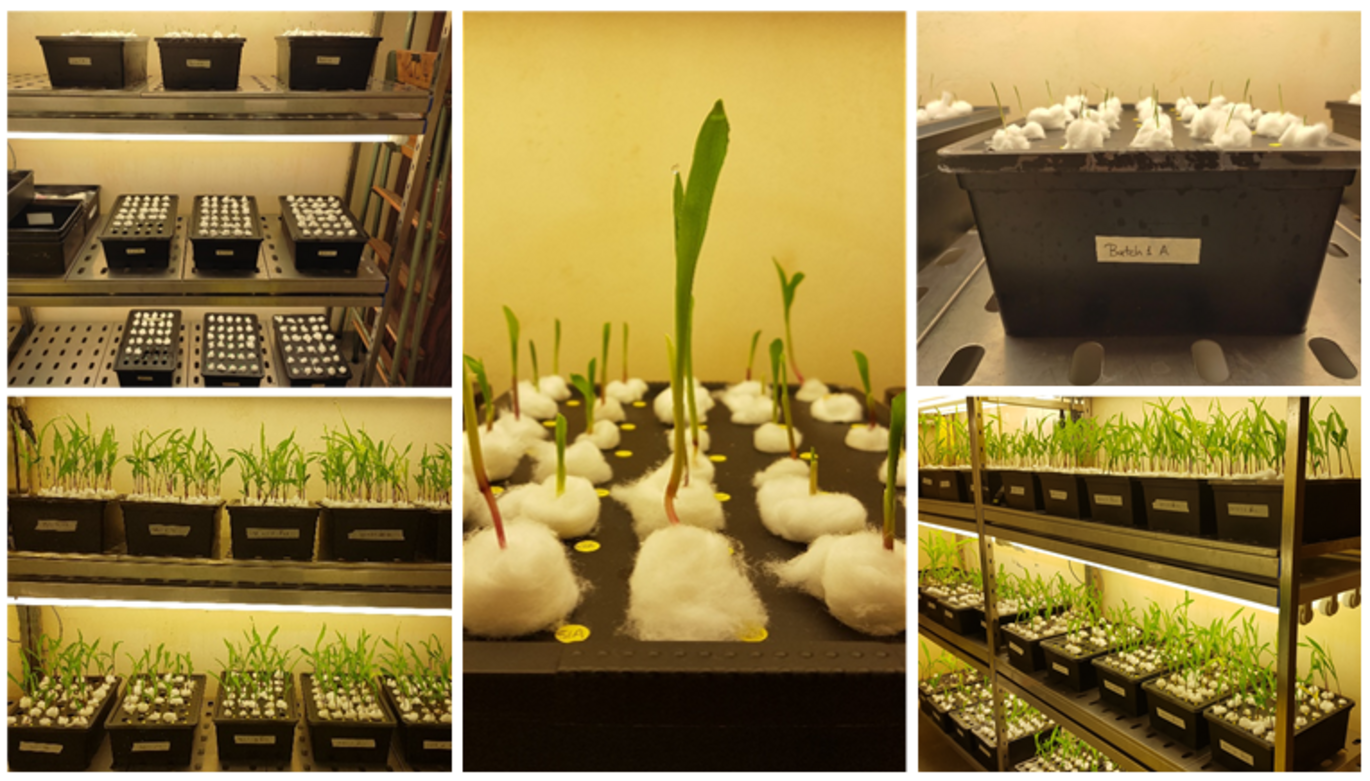Phenotyping maize and sorghum at an early development stage in controlled environments
In the frame of Work Package 1 of the project, taking place in the department of Crop Production and Biostimulation Laboratory at ULB in Brussels (Belgium), the first task consisted in a morphological evaluation of root traits at an early development stage in controlled environments – hydropony under two abiotic stress conditions: nitrogen and hydric deficiency.

C4FUTURE is focused on nitrogen (N) and water (H2O) since those soil resources are considered as the most important limitations to yield stability. On one hand, mineral N fertilization is used to increase crop yield, but excessive concentrations of nitrate are detrimental to the environment and the human health. On the other hand, the impact of climate change on crop yield is a reality in Europe and drought is the main driver of losses for cereal crops.
Optimizing root system architecture could enhance the crop capacity for soil exploration and, thus, nutrient and water acquisition. A current challenge for plant breeding is the limited ability to phenotype the root organ, a lack of methods for non-invasively imaging root organs has restricted the understanding of the genetic basis of root system architecture.
The plant material utilized was two panels of 279 genotypes of maize and 179 genotypes of sorghum (figure 1):
Two different kinds of tests were performed on the two collections, one for evaluating the roots and another for evaluating the aerial part of the plant.
For the root test, a ‘pouch & wick’ hydroponic system, consisting of a “sandwich” of two rigid plates and a blue germination paper covering the seedling (figure 2) captured the 2D root morphology of the maize and sorghum diversity panels under controlled conditions, what means ideal conditions (temperature, humidity, photoperiod, nutrients) for the two species growth.
After 4 days in a hydroponic solution, roots were scanned and then analysed with the program RootNav. Different parameters of the architecture of the root were measured:
For the test of the aerial part of the plant, plants were characterized from a physiological point of view, in order to know the health status of the leaves. In this sense, it is also important to understand how stress factors affect shoot growth and photosynthesis and how these traits are related with root morphology.
Plants were grown on hydroponics containers during 3 weeks under control conditions (figure 3), the same ideal conditions utilized for the root test. Various physiological parameters were measured every week of the test.
- Measurements:
- Fresh plant biomass 7 and 14 days after putting the seedling on the container
- Fresh root and shoot biomass 21 days after
- Dry shoot and root biomass 25 days after
- Amount of Chlorophyl, carotenoids and anthocyanins with Polypen device (handheld spectro-radiometer) through the leaf reflectance
- Normalized Difference Vegetation Index (NDVI) with Polypen
- Nitrogen balance index (NBI), an indicator of N sufficiency with Polypen
- Photosystem II activity with a Plant Efficiency Analyser Fluorometer
As a first and important result of the tests performed, there was a wide diversity of root morphology among the lines tested, both in maize and sorghum panels (figure 4). We observed genotypes with a long main root, with short main root, with a lot of lateral roots and without or few lateral roots. The same we can say about the physiological parameters measured on the leaves, there was a big diversity in the photosynthetic activity and the different parameters related to the reflectance of the leaf, concerning both species of study.
These first results of WP1 have already some applications. In the short term, the most interested genotypes extracted from these two tasks have been selected according to their contrasted root characteristics and biomass. These genotypes have been sent to our colleagues in Germany (FhG-IIS). They will capture 3/4D root architecture in soil pots by X-ray Computed Tomography (CT), which allows a non-destructive determination of root system.
In the medium term, all the data collected will be essential as phenotyping for the genetic approaches planned during this year.
In addition to the described tests performed in control conditions, we will also evaluate two different stress treatments: nitrogen deficiency (-N/+H2O) and water deficiency (+N/-H2O). In the case of nitrogen deficiency tests are in progress and the water deficiency tests will take place in the first trimester of the year. Then, we will be able to evaluate the effect of both stresses in the two species of study and also to identify the most resistant genotypes.
Finally, this preliminary test in chamber could serve us to predict how a genotype is going to behave on the field.